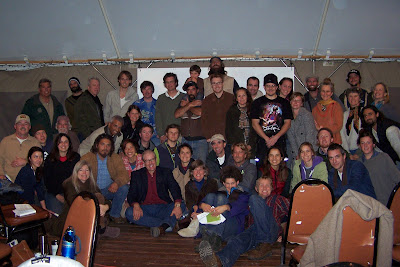I heard on the radio today that some 65 million people are regular players of the game "Farmville" on Facebook. It's a simulation game that allows people to pretend to live on a farm.
It seems there are a lot of people, tens of millions of them, who yearn for a chance to escape their complex daily lives for a few minutes or hours a week on their virtual farm.
People who live in the country know that the hours are long, money is always in short supply, that neighbors are nosy and that the work is hard and sometimes dangerous. It's not nearly as easy or simple as the "farm dream" that propels others into a virtual farm. We too find that the distance between our farm in Prince Edward Island, Canada and our suburban home in Santa Barbara, California is greater than mere miles as the jet flies.
Part of my effort on the Dunn Creek Farm blog this winter is to share with our country friends what it's like to live in the city. Just as there are those who yearn for the life they imagine they'd find on a farm, there are those who wonder what it must be like to live in a coastal resort city.
Well here are a few notes just for you.
I heard an interview with a woman on CBC Radio 1 last year. She was talking about raising kids in Urban North America and said, "We keep our children under virtual house arrest." She was talking about the piles of homework schools send home and the supervised play and activity and the restrictions we place on our kids because of fear. I immediately added to that the hours logged onto video games and TV. Her words have stayed with me.
In the country, we send our kids to the beach, or to the neighbors to play and they walk or bike most places around us. We know they can find their way home. We know that everyone knows who they are and where they belong. And they know that we'll hear about any mischief they get into.
But here, we city people tend to pack our kids into a van and shuttle them off to school and afternoon play dates. We create and schedule organized activities. We have eliminated unsupervised play time and yes, the rest of the time our children are under virtual house arrest. There is very little real freedom for kids here. That thought has troubled me lately. If we want to raise kids to appreciate and value living in a free society, this hardly seems to be the way to go about it. Especially since what we model for them says, "be afraid of your surroundings and don't trust others." It's an extension of the same thinking that keeps us disconnected from nature and willingly ignorant about what sustains and gives us life. It also explains why a lot of kids are overweight and listless. And so today I went on a mission.
My nine year old has a friend who lives about three miles away. When the boys want to get together it's an effort to arrange parent pickup and dropoff, scheduled arrival and departure and of course we must work around all those scheduled activities.
Today I said to him, "We could ride our bikes over to your friends house. And then he could ride back here with us. I can show you boys the shortcuts where cars don't go and we can stay off of the busy streets." He paused and seemed doubtful. So I persisted. "It'll only take us about 15 minutes to get there." He brightened up, put on his shoes and got out his bike.
The ride is almost the same as the route I took to and from high school every day for four years. We had no school bus then and almost nobody thought they had to give their kid a ride to school every day. We all biked or walked in our year 'round climate.
It was beautiful and sunny today as we left our house and crossed past my boy's school heading up through the rolling hills of our San Roque neighborhood. The route took us past my old home street and we stopped near the top of the hill to rest. Then, like Radar on MASH, my ears picked up a familiar sound from 40 years ago. An ice cream truck!
My son didn't hear it. When he did, I had to explain to him what it was. "It's ice cream!" Again my boy looked dubious. The beat-up old truck came chugging toward us with it's merry music blaring and I waved it to a stop. We got a couple of Life Saver flavored popcicles. And there, on the same street where I once ran for the ice cream truck with a shiny dime in my hand, I caught up with it and felt like a 9 year old again. Until that moment my 9 year old never even knew such a thing ever existed.
We met our friend and took off again for home. After a short stop to visit grandma (and the house I grew up in) I told the boys they'd have to navigate on the way back. "Which Way?" they'd say. "Pick a direction" I'd answer. And off we'd go. With a little help they managed to find the way.
As we flew down the streets they learned to dodge cars, play chase and had a running pretend shootout that lasted for a mile. It was fast and it was spontaneous. It was full of laughs and a taste of adventure. It was freedom.
Today's Streetparked Classic 1939 Ford Truck
1939 Ford Truck (click to enlarge)
 Joel has energy and conviction to burn and we all felt the heat, even in the cold and drafty confines of our classroom at El Capitan Canyon Campground. The winter Pacific storm that passed overhead during the day made mother nature herself present in the conversation, nearly drowning out the man. He carried on, his voice breaking as he shouted his words over the static of rain on the canvas roof. It was a remarkable confluence of events. As I said to him later, "Twelve inches of rain a year and you got to be here for 20 percent of it."
Joel has energy and conviction to burn and we all felt the heat, even in the cold and drafty confines of our classroom at El Capitan Canyon Campground. The winter Pacific storm that passed overhead during the day made mother nature herself present in the conversation, nearly drowning out the man. He carried on, his voice breaking as he shouted his words over the static of rain on the canvas roof. It was a remarkable confluence of events. As I said to him later, "Twelve inches of rain a year and you got to be here for 20 percent of it."
























































